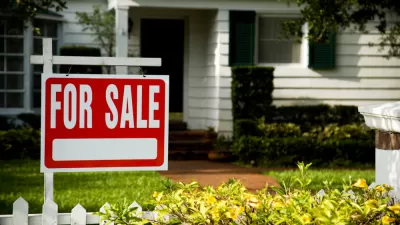The locations with the fastest growing populations are seeing the most dramatic increase in investor-owned single-family housing rentals.

The recently published “State of the Nation’s Housing” report, from the Joint Center for Housing Studies of Harvard University, sheds new light on the trends in institutional investors buying up housing stock in the U.S. real estate market—a controversial and hotly debated topic in planning and housing circles.
Alexander Hermann, a research associate at the Joint Center for Housing Studies, writes an article explaining the report’s findings, noting that “investor purchases of single-family homes reached new heights during the pandemic, particularly lower-cost units and homes in Sunbelt markets.” The trends have coincided with a shift in the makeup of ownership of single-family rentals. “Most notably, a growing share of rental properties are owned by business entities and medium- and large-scale rental operators,” according to Hermann.
Hermann breaks down the significant takeaways about single-family residential rentals into eight major categories:
- Single-family rentals have long been a substantial part of the rental stock.
- Investor activity in the single-family market increased significantly since the start of the pandemic.
- Investors are most likely to purchase lower-cost homes.
- Investor activity is especially pronounced in Sun Belt markets with strong rent and population growth.
- Investor activity increased for investors of all sizes since the start of the pandemic, though much of the growth was driven by large investors.
- Rental property ownership is shifting away from individual ownership toward more ownership by business entities.
- Large rental operators own a small share of the single-family rental stock.
- Single-family rental construction hit record highs during the pandemic.
More detail on each of those eight takeaways is available at the source article, linked below. The findings of the Harvard report would seem to contradict a Wall Street Journal article based on data from Redfin, picked up by Planetizen in November 2022, about a 30 percent decline in investor purchases of single-family rental homes. The Harvard report does say that investor purchases peaked in early 2022, before “moderating” through the rest of that year and into 2023, however.
FULL STORY: 8 FACTS ABOUT INVESTOR ACTIVITY IN THE SINGLE-FAMILY RENTAL MARKET

Trump Administration Could Effectively End Housing Voucher Program
Federal officials are eyeing major cuts to the Section 8 program that helps millions of low-income households pay rent.

Planetizen Federal Action Tracker
A weekly monitor of how Trump’s orders and actions are impacting planners and planning in America.

Ken Jennings Launches Transit Web Series
The Jeopardy champ wants you to ride public transit.

Crime Continues to Drop on Philly, San Francisco Transit Systems
SEPTA and BART both saw significant declines in violent crime in the first quarter of 2025.

How South LA Green Spaces Power Community Health and Hope
Green spaces like South L.A. Wetlands Park are helping South Los Angeles residents promote healthy lifestyles, build community, and advocate for improvements that reflect local needs in historically underserved neighborhoods.

Sacramento Plans ‘Quick-Build’ Road Safety Projects
The city wants to accelerate small-scale safety improvements that use low-cost equipment to make an impact at dangerous intersections.
Urban Design for Planners 1: Software Tools
This six-course series explores essential urban design concepts using open source software and equips planners with the tools they need to participate fully in the urban design process.
Planning for Universal Design
Learn the tools for implementing Universal Design in planning regulations.
Heyer Gruel & Associates PA
Ada County Highway District
Institute for Housing and Urban Development Studies (IHS)
City of Grandview
Harvard GSD Executive Education
Toledo-Lucas County Plan Commissions
Salt Lake City
NYU Wagner Graduate School of Public Service





























